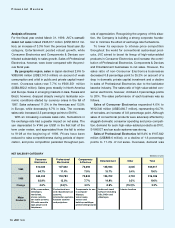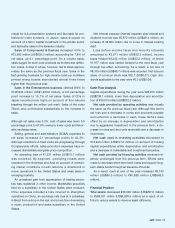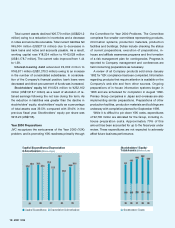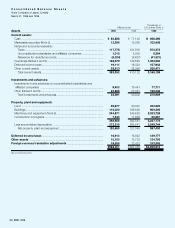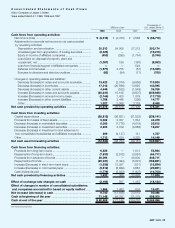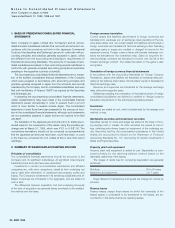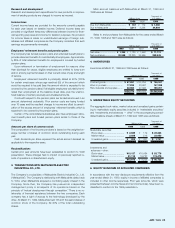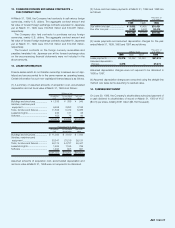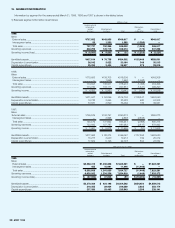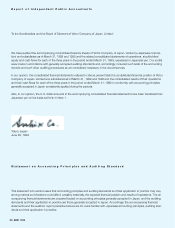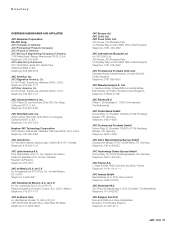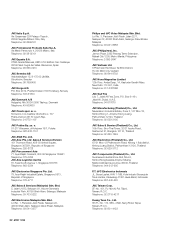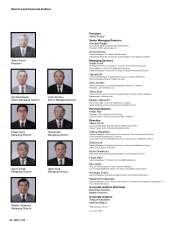JVC 1999 Annual Report Download - page 28
Download and view the complete annual report
Please find page 28 of the 1999 JVC annual report below. You can navigate through the pages in the report by either clicking on the pages listed below, or by using the keyword search tool below to find specific information within the annual report.
26 JVC 1999
7. INCOME TAXES
Income taxes in Japan consist of corporation, enterprise and inhabi-
tants taxes. The Company and its domestic consolidated subsidiaries
are subject to the income taxes referred to above which, in the aggre-
gate, resulted in normal effective tax rates of approximately 48% for the
year ended March 31, 1999 and 51% for the years ended March 31,
1998 and 1997. Foreign subsidiaries are subject to income taxes of the
countries in which they domicile. The actual effective tax rates differ
from the normal effective rate mainly because of (1) tax reductions for
dividend income received from Japanese companies and (2) expenses
not deductible for income tax purposes.
8. SHORT-TERM BANK LOANS AND LONG-TERM DEBT
Short-term bank loans of certain of the Company’s consolidated sub-
sidiaries consist of notes maturing generally in three months. The ap-
plicable annual interest rates on short-term bank loans outstanding at
March 31, 1999 and 1998 ranged from 0.575% to 19.0% and from
1.2% to 20.0%, respectively.
Long-term debt at March 31, 1999 and 1998 was as follows:
Thousands of
Millions of yen U.S. dollars
1999 1998 1999
1.4% unsecured convertible
bonds due 1999 ........................ ¥—¥20,431 $—
1.5% unsecured convertible
bonds due 2005 ........................ 11,483 11,483 94,901
0.35% unsecured convertible
bonds due 2002 ........................ 19,999 19,999 165,281
0.55% unsecured convertible
bonds due 2005 ........................ 20,000 20,000 165,289
4.3% Eurobonds due 2000.......... 9,765 10,700 80,702
1.375% unsecured
bonds due 2001....................... 5,000 —41,322
1.75% unsecured
bonds due 2003....................... 5,000 —41,322
2.15% unsecured
bonds due 2005....................... 10,000 —82,645
1.30% guaranteed
notes due 2001........................ 5,180 —42,810
1.61% guaranteed
notes due 2002........................ 4,914 —40,612
Loans, primarily from banks
with
interest principally at 1.44%
to 8.95%
Secured.................................. 379 561 3,132
Unsecured .............................. 12,494 7,503 103,256
Other ........................................... 545 649 4,505
.................................................... 104,759 91,326 865,777
Less current portion..................... 15,733 20,431 130,025
.................................................... ¥ 89,026 ¥70,895 $735,752
The 1.5% unsecured convertible bonds are redeemable prior to their
stated maturity, in whole or in part, at the option of the Company at
prices ranging from 107% to 100% of the principal amount, respec-
tively. The price at which shares of common stock shall be issued upon
conversion is ¥2,867 ($23.69) per share, subject to adjustment under
certain circumstance. The 0.35% and 0.55% unsecured convertible
bonds are redeemable prior to their stated maturity, in whole or in part,
at the option of the Company at prices ranging from 102% to 100%
and 103% to 100% of the principal amount, respectively. For both is-
sues, the price at which shares of common stock shall be issued upon
conversion is ¥1,487 ($12.29) per share, subject to adjustment under
certain circumstance.
The aggregate annual maturities of long-term debt at March 31,
1999 were as follows:
Thousands of
Year ending March 31 Millions of yen U.S. dollars
2000 ................................................... ¥ 15,733 $130,025
2001 ................................................... 26 215
2002 ................................................... 10,585 87,479
2003 ................................................... 24,939 206,108
2004 ................................................... 8,920 73,719
Thereafter............................................ 44,556 368,231
........................................................... ¥104,759 $865,777
9. PLEDGED ASSETS
The following assets were pledged as collateral for long-term debt and
accrued expenses at March 31, 1999:
Thousands of
Millions of yen U.S. dollars
Investments......................................... ¥ 8 $ 66
Machinery and equipment ................... 379 3,132
Finished goods.................................... 145 1,198
........................................................... ¥532 $4,396
10. CONTINGENT LIABILITIES
The contingent liabilities of the Company and its consolidated sub-
sidiaries at March 31, 1999 were as follows:
Thousands of
Millions of yen U.S. dollars
As endorser of export bills
discounted with banks........................ ¥ 9,574 $ 79,124
As guarantor for loans to
employees.......................................... 17,573 145,231
As guarantor for loans to
affiliated companies............................ 759 6,273
........................................................... ¥27,906 $230,628
11. STOCKHOLDERS’ EQUITY
Under the Commercial Code of Japan (the “Code”), at least 50% of the
issue price of new shares, with a minimum of the par value thereof, is
required to be designated as stated capital. The portion which is to be
designated as stated capital is determined by resolution of the Board of
Directors. Proceeds in excess of the amounts designated as stated
capital are credited to additional paid-in capital.
In accordance with the new disclosure requirements effective from
the year ended March 31, 1999, legal reserve is included in retained
earnings for 1999. Previously it was presented as a separate compo-
nent of the stockholders’ equity. The accompanying consolidated finan-
cial statements for the years ended March 31, 1998 and 1997 have
been reclassified to conform to the 1999 presentation.
The maximum amount that the Company can distribute as divi-
dends is calculated based on the unconsolidated financial statements
of the Company in accordance with the Code.


